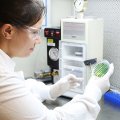A University of Queensland study could help improve profits for farmers by allowing more kilograms of beef to be produced per hectare without increasing herd numbers.
Dr Viv Perry, from the School of Veterinary Science’s Pastoral Veterinary Centre at Goondiwindi, is manipulating the protein intake of cows during pregnancy to see if this can increase beef calf weaning weights.
In a series of studies Dr Perry demonstrated that protein supplementation directly affected placental growth and that varied maternal protein intake resulted in changes in calf growth and body composition at six months of age.
Dr Perry said these studies also indicated that high dietary protein intake during the second trimester was associated with faster growth rates in the calves while increased protein intake in the first trimester resulted in increased body fat.
“Farmers are paid per kilogram of beef they produce. If you can increase weaning weights with relatively little increase in cost it means farmers will increase profits,” Dr Perry said.
The current study will determine the effects of dietary protein during pregnancy on the postnatal development of the calf and circulating hormone and growth factor levels known to affect foetal development.
The project has received funding from Meat and Livestock Australia (MLA) and the largest cattle producing company in the world the Australian Agricultural Company (AAco). Livestock feed company Primix have supplied the protein meal.
“In essence it is simply a process of replicating what is actually happening in range cattle,” Dr Perry said.
“Cows usually experience a fall in protein intake during the autumn and winter. We are finding out if supplementing cattle with a simple protein supplement will enable farmers to obtain better growth rates in their calves.”
The study will also consider the possible effects that added protein intake during pregnancy may have on calving difficulties (dystocia) as changes in protein intake during pregnancy could cause an increase in calf birth weights.
Dr Perry said the study was aiming to increase weaning weights without increasing calving difficulties.
“The effects of varied protein content in the maternal diet during pregnancy are particularly relevant to the cattle industry in Australia as protein is the most deficient nutritional component in the Australian rangelands,” she said.
“Furthermore there is preliminary evidence that the rate of dystocia among heifers in the Brigalow-Belah belt of Australia is related to high levels of protein in the diet.”
During the current study the veterinary team at the Goondiwindi Pastoral Veterinary Centre will take blood samples from the pregnant cows to measure circulating hormone levels and perform a monthly ultrasound examination to assess how foetal growth is affected by the supplement.
The researchers will assess the effects of the feeding regime during pregnancy on growth rates, muscle, fat and bone ratios in the offspring over the following year.
Dr Perry said it was clear from a worldwide series of epidemiological studies in human populations and experimental studies in a range of animal models that varying maternal nutrition during critical periods of foetal development could alter or program body mass and body composition in later life.
“During the past decade, there has been a major experimental focus on determining the impact of varying maternal nutrition on the subsequent growth and metabolic development of laboratory species but little has been done on large domestic species of commercial importance,” she said.
Media: For more information, contact Dr Perry (telephone 07 4671 1799, email: v.perry@uq.edu.au) or Chris Saxby at UQ Communications (telephone 07 3365 2479, email: c.saxby@uq.edu.au).
.jpg)



